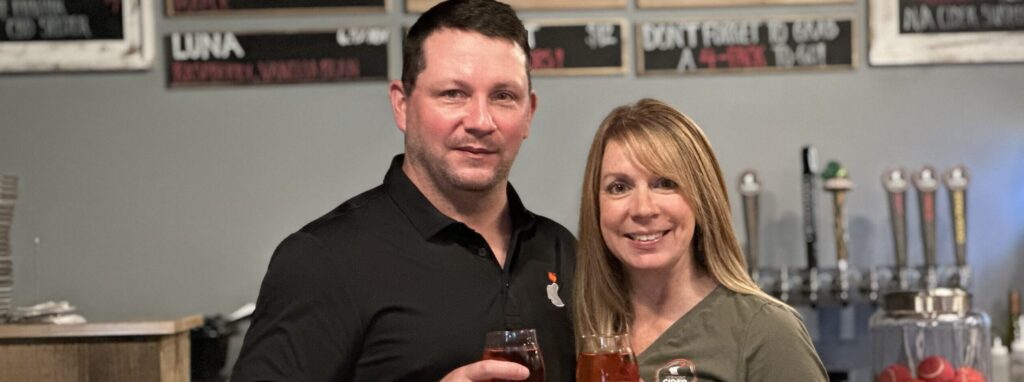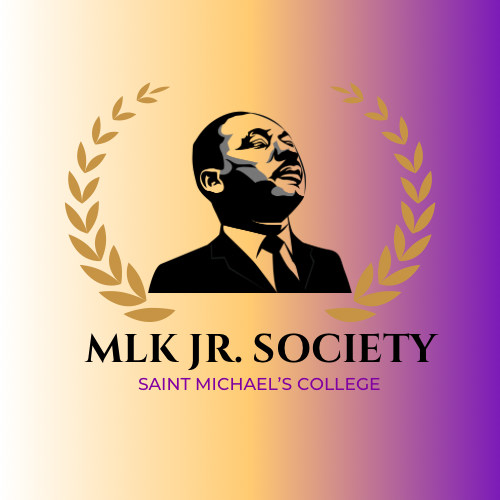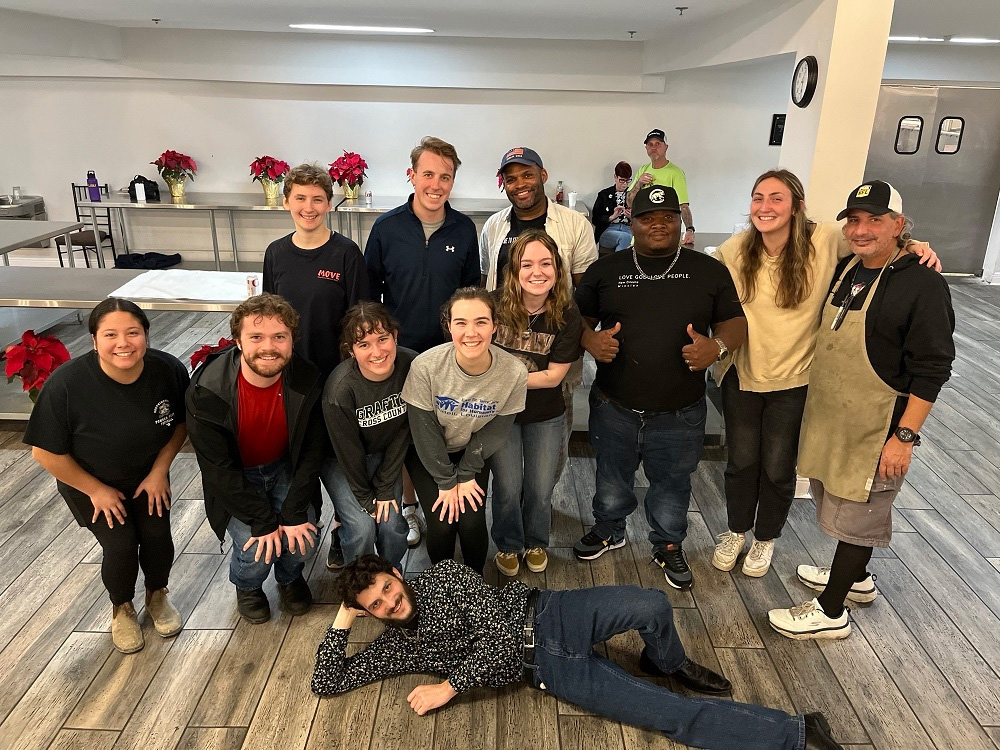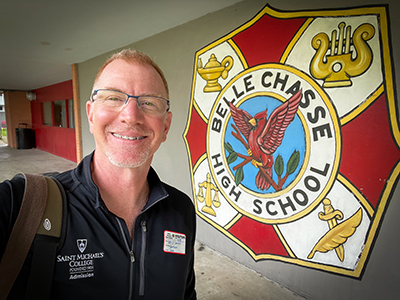Surprises, adjustments all part of summer research
One by one, Saint Michael’s College mentored summer research students stood by their tables in Alliot Hall Tuesday to describe their challenges, surprises, adjustments and early outcomes from more than a month of wide-ranging work.
Nearly an hour later when they were done, Karen Talentino, vice president for academic affairs and a sponsor through her office of these periodic meals together with mentors, administrators and staff, said this year’s projects “may span the greatest breadth of disciplines and topics that we’ve ever had here.”
The gathering was one of three such each year designed to track progress on summer research in a mutually supportive group environment. A brunch in June allowed students to introduce their projects and what they hoped to accomplish. Now, Talentino said to start, it was time to practice a one-minute “elevator speech” on what it has all meant to them and how their work has gone, since coming presentations and conversations with different constituencies will require that ability.
As ever over more than a decade of these research-lunch reports, not everything has been turning out as planned — which is all part of the learning experience, Talentino reminded. Some of the student reports:
Jade Jarvis ’19 of Derby, VT said she and her research partner Alyssa Valentyn ’19 of Medford, MA, both working with Declan McCabe of biology, are still in the late stages of collecting full data before they can reach meaningful conclusions on the effects of human presence on richness and abundance of various animal species in wooded and non-wooded areas. They’ve seen slight differences which, if they increase, might allow them to reach more meaningful conclusions on the effects of human presence, she said.
From the next table to share, student-scientists including Jessica Tidd (Olympic Valley, CA; mentor Mark Lubkowitz, biology) reported on research into the transfer of sugars in corn, which might affect biofuels, or stronger roots for stronger crops in dryer climates – and, while she reported no major surprises, the work is going well and she is seeing the potential practical application of the work more clearly, Tidd told Talentino under questioning from the VPAA.
David Baird of Higganum, CT, had an update on his history project with mentor George Dameron to see if history’s experiences on European refugees can be predictors for the present refugee/humanitarian crisis there. He is focusing on the Jewish refugee crisis during the Black Death of the 1300s, when relatively enlightened rulers in Poland and Austria welcomed Jewish refugees who had been ousted by other nations out of fear and prejudice; the more welcoming nations benefitting greatly economically, socially and culturally from those refugees, research shows. “We could expect similar economic benefits” from nations that welcome refugees in the Syrian refugee crisis, he postulated, based on his work so far.
Emily Chabot said that in her study of zebra fish with Professor Ari Kirshenbaum with the goal of quantifying their basic neurobehavioral processes, an interesting challenge had been their finding results that are the opposite of findings that she had read in a “literature review” in conjunction with/preparation for her work.
Kevin Jeter said that with English Professor Will Marquess, he is studying Margaret Atwood’s Madadam Trilogy as a way into issues of climate change and religion. “My work focuses on finding if the trilogy is anti-science or just appears to be,” he said, describing evidence on the point that has emerged from his reading.
Samuel Vaal said his chemistry work with Shane Lamos – sampling water from a river in Stratford adjacent to a copper mine before running it through College spectroscopy equipment –has shown “not as much pollutions in the samples first suggested” in the water, which they were relieved to find –“but we found very high amounts of metals in the soils, so we’re looking at that.”
Jordan Roach said his work with David Heroux in chemistry examining zirconia catalysts has shown “some promising results,” with their results in a few cases showing their products work better than some commercial things for similar purposes. Amanda Spink said her work with Heroux on Mesoporous Tungsten Oxide synthesis and characterization “didn’t really work out,” but they are trying “to refine and perfect our procedures – I learned if it doesn’t work, keep trying.” Commented Talentino, “such serendipity is one of the most important phenomena in scientific discovery.” Another Heroux student, working on biofuels that would ideally contain less phosphorous, said she is running her last set of samples but still can’t say conclusively which solvent will be best in the final product — though she is seeing some trends so far.
Andrew Boucher, doing chemistry research under Professor Bret Findley, said he is testing theories on solvents to see if the interaction is based off static or dynamic theory — he’s now leaning more toward static theory for explaining the interaction basis.
Saad Alharbi of Saudi Arabia talked of roadblocks in his research with Christina Chant of chemistry into date plants – they had hoped to devise useful classroom experiments for students using the date fruits – but he soon learned that one of the lab experiments they had hoped to devise was not workable because it involved “very toxic and dangerous chemicals” that made it not feasible for a teaching classroom.
Brian Shearer is examining food waste issues with Michael Bosia in political science. He said he has talked to school administrators and other community leaders to gauge awareness on food waste, and possibly devise ways to reduce it. He has spread awareness on relatively lenient regulations that might incentivize more districts to donate food that otherwise would be wasted; one big part for him has been the chance to educate kids more on food waste, he said.
Hanna Lesch said she and her adviser Valerie Bang-Jensen in education have talked with an editor at an education magazine who might be interested in their examination of alternative education programs, and their effects on student learning, parents and teachers. Issues include equity given the cost of such programs, with not all families being able to afford them — and also, extended time out of class and its effects on teacher planning, weighed against great enrichment and student excitement about their work through such programs.
The issue of “returning to learn after concussions” for college-aged students in particular is the focus of Meg Murray’s research alongside Kristin Gehsmann of education. They’ve been invited to present findings at a fall Vermont conference on brain injury, and they will present to Saint Michael’s faculty, before revisions in hopes of presenting on a national level, she said.
Julia Morrison, working with Jonathan Silverman in education, had visual aids to help explain her work on creativity in children. She said she tweaked her original plan – a children’s book to spark kids’ imaginations – and now is completing a visual journal, based in interviews with teachers and children. She showed journal pages illustrated with colorful art alongside a paragraph or quote from her research. She admitted how “it was hypocritical of me to research the possible negative effects on creativity of technology, and yet the work would not have been possible without technology!”
The most important thing Morgan Beck learned in her study under Adrie Kusserow of student and parent perceptions of education in Vermont among Sudanese refugees is “the significance of additional support programs” for the refugee families.
A highlight for Emily Galow in her English project on Shakespeare’s Twelfth Night through lenses of gender and sexuality, directed by veteran Shakespeare expert and English Professor Emeritus Nick Clary, has been corresponding with a couple of internationally acclaimed academics about the performance history of the play, Galow said. Her goal is a paper on why these issues are essential to the history, revitalization and relevance of the play, she said.
A large group at one table brought everyone up to date on their work with mentor Ruth Fabian-Fine using Central American spiders to research central nervous systems, neurotransmitters, sensory overstimulation, and other topics. One group member likened the spiders’ experience of sensory overstimulation “like a human being stuck in a nightclub for days and days at a time – not too pleasant.”
The large water-quality lab group told of ongoing research on suspended solids in water samples; Kelley Gilhooly, a student working with Declan McCabe in biology, said her entomology research involves going out to water, “putting on waders and collecting bugs,” and “it’s actually fun” bringing them back to the lab to ID.
Lauren Stone said while some might question using a research grant for writing and revising a novel, as she has, “who else can say they have become eight different people they know to their core – this summer I’ve had to live many lives, die twice, persist through endless plot twists and feel every emotion they would.” She mainly learned that the writing process is all about revision – she and mentor Liz-Inness Brown of English have revised 21 chapters and over 150 pages, with 20 rewrites, and “I couldn’t be prouder … I’m so happy how it came out,” Stone said.
An interesting finding for Thomas Boullier in his economics work with Patrick Walsh and Tara Natarajan, comparing impacts of hosting a sporting mega-event like the Olympics or FIFA World Cup on developed and developing countries, is that hosting the Olympics actually slows GDP growth, but only being considered to host (without having to) actually accelerates it.
Ryan Kirkpatrick, also in economics with Walsh, wanted to know “if we can predict President Trump’s proposed policies’ outcomes” using a certain hypothesis about stocks. Several tests so far came back statistically significant, which is a good outlook for their research, he said, but they still have to delve into more detail to see how different industries might be affected.
Two students researching different “soil amendments” in the Permaculture site garden and their effects on beans and corn, based on water flows, said their results this year are more concrete than similar study last summer, showing “sometimes things don’t work out just as planned, and sometimes they work out better.”
The group working on DNA origami in the longstanding lab of Jo Ellis-Monaghan (mathematics) and Greta Pangborn (computer science) were able to show several of their constructs were so efficient, they “couldn’t get any better, ” which would be useful where scientists are trying to optimize applications in various nanoscale ventures, Pangborn said later.
Chris Boutin said he hopes his work creating a program structure for a veteran gardening initiative at the Permaculture site would benefit vets in the community and provide a base for future research (see a related story on Chris’s work on College website news section).
Concluded Talentino, “It’s really wonderful to see so many parts of the College involved in this program – I want to thank faculty for agreeing to work with students this summer, and students for the hard work you’ve been putting into this.”






